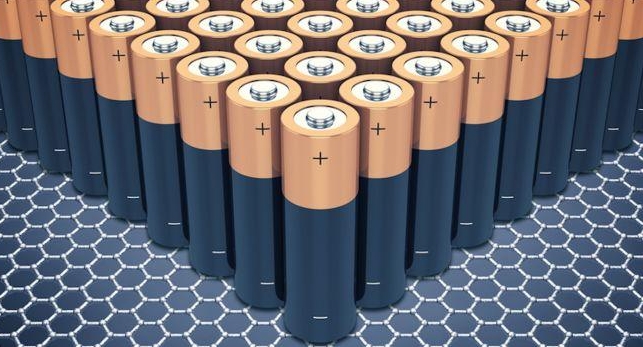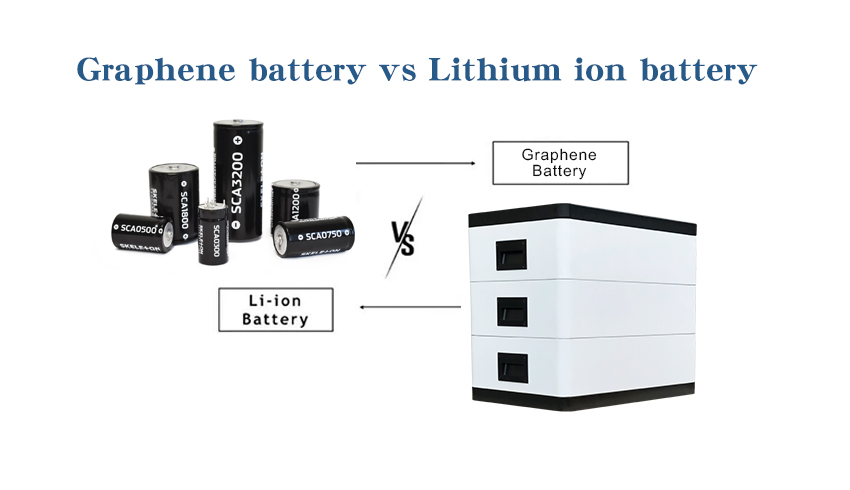효율적이고 지속 가능한 에너지 솔루션에 대한 수요가 증가함에 따라, 그래 핀 배터리와 리튬 배터리는 두 명의 기대되는 경쟁자가되었습니다..
하지만, 어느 것이 당신의 요구에 더 적합합니다?
전기 자동차에 적합한 전원을 찾고 있는지 여부, 스마트 폰, 또는 재생 가능 에너지 시스템, 이 안내서는 핵심 장점을 탐구 할 것입니다, 제한, 그리고 현명한 선택을하는 데 도움이되는 미래 개발 전망.
그래 핀 배터리 란 무엇입니까??

그래 핀 배터리의 구성
그래 핀 배터리는 그래 핀을 주요 재료로 사용하는 에너지 저장 장치입니다..
그래 핀 벌집 격자 구조에 배열 된 탄소 원자로 구성된 단일 층 재료입니다., 우수한 전기 전도성과 기계적 강도에 많은 관심을 끌었습니다..
그래 핀 배터리에서, 그래 핀은 일반적으로 전극 재료로 사용됩니다, 전해질 및 다른 상보적인 재료와 함께 배터리의 기본 구조를 형성합니다..
그래 핀 배터리는 상당한 이점으로 인해 전통적인 배터리 기술에 대한 이상적인 대안이되었습니다., 주로 다음 측면에 반영됩니다:
빠른 충전 기능:
그래 핀 배터리는 충전 수용 성능이 뛰어나고 빠른 충전을 달성 할 수 있습니다..
이 기능은 전기 자동차 및 빠른 에너지 보충이 필요한 휴대용 전자 장치와 같은 응용 분야에서 특히 중요합니다..
높은 에너지 밀도:
그래 핀 배터리의 에너지 밀도는 전통적인 리튬 배터리보다 훨씬 높습니다., 이는 그래 핀 배터리가 동일한 질량과 부피로 더 많은 에너지를 저장할 수 있음을 의미합니다..
이것은 장치의 배터리 수명을 연장 할뿐만 아니라, 또한 전반적인 효율성을 향상시킵니다.
긴 서비스 수명:
그래 핀의 높은 내구성 및 분해 저항은 배터리의 서비스 수명을 크게 연장합니다..
수명이 길면 배터리 교체 빈도가 낮다는 것을 의미합니다., 장기적으로 더 비용 효율적인 솔루션입니다..
보안 강화:
그래 핀 배터리는 안정성이 높고 열 런 어웨이가 덜합니다..
열 런 어웨이는 전통적인 리튬 배터리의 화재 또는 폭발의 주요 원인입니다., 그래 핀 배터리의 장점은 전기 자동차 및 에너지 저장 시스템과 같은 응용 분야에서 더 안전하게 만듭니다..
환경 친화 성:
탄소 기반 물질로, 배터리에 그래 핀을 적용하면 환경의 지속 가능한 개발을 촉진하는 데 도움이됩니다..
독성 요소에 의존하는 전통적인 배터리에 비해, 그래 핀 배터리는 더 깨끗하고 환경 친화적 인 옵션입니다..
리튬 배터리는 무엇입니까??
리튬 배터리는 충전식 에너지 저장 장치입니다, 주로 리튬 화합물로 구성된 양성 및/또는 음성 전극으로.
작동 원리는 충전 및 배출 공정 동안 양성 및 음성 전극 사이의 리튬 이온의 앞뒤 움직임을 기반으로합니다..
리튬 이온 배터리 (리튬 이온) 가장 일반적인 유형의 리튬 배터리입니다, 휴대용 전자 장치에서 널리 사용됩니다, 전기 자동차, 재생 가능한 에너지 저장 시스템.
리튬 배터리는 수많은 장점으로 인해 매우 선호됩니다.:
높은 에너지 밀도:
리튬 배터리는 높은 에너지 밀도와 많은 양의 에너지를 소형 부피에 저장하는 기능으로 알려져 있습니다..
이 기능은 매우 높은 크기와 체중이 필요한 응용 프로그램에 이상적인 선택입니다., 스마트 폰 및 노트북과 같은.
긴 사이클 수명:
리튬 배터리는 충전 배출주기 수명이 길고 여러 용도로도 높은 용량을 유지할 수 있습니다..
이것은 그들이 더 오랜 시간 동안 성능을 유지할 수 있음을 의미합니다., 따라서 교체 주파수를 줄입니다.
경량 디자인:
다른 많은 배터리에 비해, 리튬 배터리는 무게가 가볍습니다, 휴대용 장치에서의 응용 프로그램에 대한 상당한 이점을 제공합니다..
가벼운 설계는 장치의 휴대 성과 사용자 경험을 향상시킵니다..
높은 방전율:
리튬 배터리는 고전류를 빠르게 출력 할 수 있습니다, 즉각적인 고전력이 필요한 응용 프로그램에 중요합니다., 전기 자동차와 같은, 전동 공구, 고성능 장비.
성숙한 기술:
리튬 배터리는 광범위한 연구 개발을 거쳤습니다, 그리고 그들의 기술은 매우 성숙해졌습니다.
대규모 응용 프로그램은 비용 효율성을 가져 왔습니다, 리튬 배터리를보다 저렴하고 인기있게 만듭니다.
그래 핀 배터리 대 리튬 이온 배터리
그래 핀 배터리와 리튬 이온 배터리의 비교는 여러 측면에서 수행 할 수 있습니다., 다음은 두 가지를 포괄적으로 비교하는 것입니다.:
1. 에너지 밀도
그래 핀 배터리:
에너지 밀도가 높습니다, 이론적으로 리튬 배터리의 몇 배.
예를 들어, 그래 핀 배터리의 특정 에너지에 도달 할 수 있습니다 600 Wh/kg, 보다 훨씬 높습니다 180 리튬 배터리의 WH/kg.
리튬 배터리:
에너지 밀도는 비교적 낮습니다, 그러나 전기 자동차 및 휴대용 장치에서 널리 사용되었습니다..
2. 충전 속도
그래 핀 배터리:
빠른 충전 속도, 짧은 시간 안에 충전을 완료 할 수 있습니다.
예를 들어, 3000mAh 그래 핀 배터리는 거의 절반의 용량으로 충전 할 수 있습니다. 5 분.
리튬 배터리:
충전 속도는 비교적 느립니다, 특히 저온 환경에서, 충전 효율이 더욱 감소 할 것입니다.
3. 사이클 수명
그래 핀 배터리:
긴 사이클 수명, 수명이 있습니다 2-3 리튬 배터리의 시간.
리튬 배터리:
사이클 수명이 더 길다, 그래 핀 배터리만큼 내구성이 없습니다.
4. 보안
그래 핀 배터리:
안전이 더 높습니다, 더 나은 열 안정성, 열 런 어웨이가 덜 발생합니다.
리튬 배터리:
특정 안전 위험이 있습니다, 특히 고온 또는 과다 충전 조건에서, 열 런 어웨이가 발생할 수 있습니다.
5. 비용
그래 핀 배터리:
현재, 높은 생산 비용은 대규모 상업용 응용 프로그램을 제한합니다.
리튬 배터리:
저렴한 비용과 성숙한 생산 기술은 현재 주류 배터리 선택입니다..
6. 응용 프로그램 필드
그래 핀 배터리:
고성능이 필요한 시나리오에 적합합니다, 배터리 수명이 길다, 그리고 빠른 충전, 고급 전자 장치와 같은, 항공 우주, 그리고 군사 분야.
리튬 배터리:
전기 자동차에 널리 사용됩니다, 휴대용 전자 장치, 및 태양 에너지 저장 시스템.
7. 환경 친화 성
그래 핀 배터리:
더 환경 친화적입니다, 준비 과정에서 오염이 적습니다, 그리고 재활용 가능.
리튬 배터리:
비교적 환경 친화적, 그러나 리튬 자원의 제한적이고 고르지 않은 분포에 문제가 있습니다..
요약
그래 핀 배터리는 에너지 밀도에 상당한 이점이 있습니다, 충전 속도, 사이클 수명, 그리고 안전, 그러나 비용은 높고 기술은 아직 완전히 성숙하지 않습니다..
리튬 배터리는 성숙한 기술과 저렴한 비용으로 인해 주류 배터리 선택이되었습니다.. 미래에, 그래 핀 준비 기술 및 비용 절감으로, 그래 핀 배터리는 더 많은 필드에 널리 적용될 것으로 예상됩니다..
| 특징 | 그래 핀 배터리 | 리튬 배터리 |
| 에너지 밀도 | 더 높은, 볼륨 당 더 많은 에너지 저장 | 낮지 만 개선 |
| 충전 속도 | 매우 빠릅니다 | 보통의 |
| 사이클 수명 | 내구성으로 인한 수명이 길다 | 길지만 열화가 발생하기 쉽습니다 |
| 안전 | 더 높은 안전, 낮은 열 런 어웨이 위험 | 개선, 그러나 일부 위험은 남아 있습니다 |
| 비용 | 값비싼, 초기 기술 | 더 저렴하고 설립 |
| 응용 | 고성능 전자 제품, 고급 전자 장비, 항공 우주 및 군사 분야 | 전자 제품 및 EV에서 널리 사용됩니다 |
결론

끊임없는 기술의 발전으로, 연구원들은 그래 핀 및 리튬 배터리 분야에서 더 많은 혁신을 할 것으로 예상됩니다..
이러한 발전은 배터리의 성능을 더욱 향상시킬 것입니다, 비용을 줄이다, 확장 성을 향상시킵니다.
미래에, 그래 핀과 리튬 배터리 사이의 경쟁은 에너지 저장 기술의 개발을 계속 주도 할 것입니다., 전기 수요 증가를위한보다 효율적이고 지속 가능한 솔루션 제공.
자주 묻는 질문과 답변
왜 우리는 아직 그래 핀 배터리를 널리 채택하지 않았습니까??
한편으로, 그래 핀 배터리의 대규모 생산은 많은 과제에 직면 해 있습니다, 원자재의 가용성과 불완전한 인프라가 제한되어 있습니다.
이러한 요소는 공동으로 그래 핀 배터리의 홍보 및 적용을 제한합니다..
그래 핀 배터리의 단점은 무엇입니까??
그래 핀 배터리의 단점은 주로 세 가지 측면에 반영됩니다.:
첫째로, 높은 비용은 대규모 응용 프로그램을 제한합니다; 둘째로, 대량 생산은 어렵고 생산 효율성을 향상시켜야합니다.; 세 번째 도전은 확장 성입니다, 시장 수요를 빠르게 충족시키기가 어렵습니다.
미래의 배터리에 대한 희망이 될 것입니다?
그래 핀, 전도도가 우수하고 경량 특성으로, 미래의 배터리 기술로서 상당한 잠재력을 보여줍니다.
그래 핀이 리튬보다 비싸다?
그래 핀의 생산 및 가공 과정은 비교적 복잡합니다., 리튬보다 비용이 더 높아질 수 있습니다.
그래 핀을 배터리의 리튬을 교체 할 수 있습니다?
그래 핀은 특정 특정 응용 분야에서 리튬에 대한 보충 또는 대체 재료로서 작용할 수 있습니다..
하지만, 모든 유형의 배터리 기술에서 리튬을 완전히 교체하지는 않을 것입니다..
